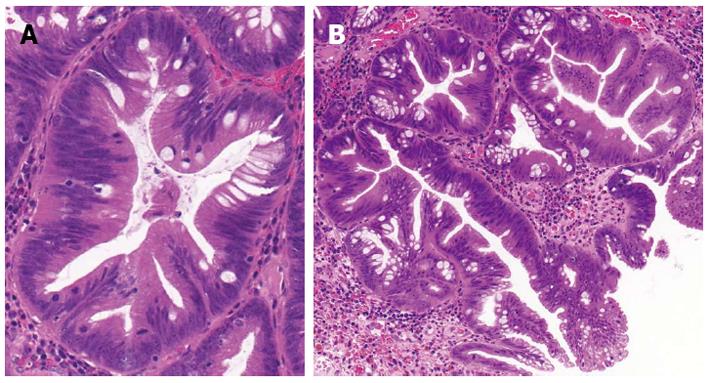Copyright
©2013 Baishideng Publishing Group Co.
World J Gastroenterol. Feb 7, 2013; 19(5): 607-615
Published online Feb 7, 2013. doi: 10.3748/wjg.v19.i5.607
Published online Feb 7, 2013. doi: 10.3748/wjg.v19.i5.607
Figure 1 Microscopic features of serrated polyps.
A: On cross section serrated crypt shows a stellate or starlike appearance; B: In longitudinal section a characteristic serrated or saw-toothed appearance can be seen.
Figure 2 Schematic representation of the sessile and traditional serrated pathways.
N: Normal mucosa; ACF-Hs: Serrated hyperplastic-type aberrant crypt focus; ACF-Hns: Non-serrated hyperplastic-type aberrant crypt focus; MVHP: Microvesicular hyperplastic polyp; OIS: Oncogene-induced senescence; GCHP: Goblet cell-rich hyperplastic polyp; SSA: Sessile serrated adenoma; TSA: Traditional serrated adenoma; SSA-HGD: Sessile serrated adenoma with high grade dysplasia; TSA-HGD: Traditional serrated adenoma with high grade dysplasia; SAC: Serrated adenocarcinoma; IGFBP7: Insulin-like growth factor-binding protein 7; MAPK: Mitogen activated protein kinase-ERK pathway; MLH1: MutL homolog 1; MGMT: O-6-methylguanine-DNA methyltransferase; CIMP-H: CpG island methylator phenotype-high; CIMP-L: CpG island methylator phenotype-low; MSI-H: High-level microsatellite instability; MSI-L: Low-level microsatellite instability; MSS: Microsatellite stable.
- Citation: Patai &V, Molnár B, Tulassay Z, Sipos F. Serrated pathway: Alternative route to colorectal cancer. World J Gastroenterol 2013; 19(5): 607-615
- URL: https://www.wjgnet.com/1007-9327/full/v19/i5/607.htm
- DOI: https://dx.doi.org/10.3748/wjg.v19.i5.607










